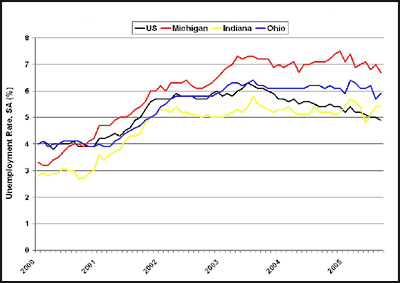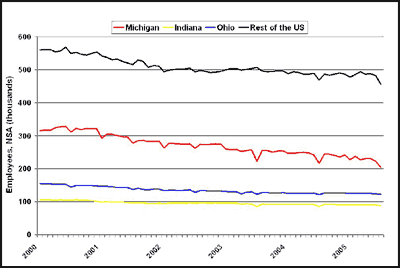Michigan Auto Woes
Michigan’s traditional heavy reliance on the domestic auto industry has been troubling its economy over the past five years. While GM and the other domestic auto makers have “kept America rolling” with continued auto sales and sales/finance incentives, the state of Michigan has shown the worst performance among the states. Michigan’s unemployment is the second highest at 6.7 %; and it holds the bottom spot for year-over-year payroll job performance with a 1.1 percent loss as of August. It is the only state to have lost jobs over this period. What are policy makers to do? The state’s heavy reliance on the automotive sector makes efforts to diversify a long-term and risky proposition at best. In the short term, hopes ride on a turnaround for the domestic auto makers and their upstream auto parts manufacturers, while long-term bets are being placed on new industries.
1. Unemployment rates for the U.S. and MI, IN, and OH: 2000-2005

Light vehicle production in the U.S. has continued to average around 12 million vehicles since 2000. However, as discussed by Thomas Klier (Chicago Fed Letter) earlier this year, it is the geographic shift of production from Michigan and other parts of the upper Midwest southward that is adversely affecting Michigan’s economy. A shift southward has accompanied the slippage in sales share of the domestic nameplate automakers—GM, Ford and Chrysler, which has fallen from a 65% share of domestic sales in 2000 to 58% in August, 2005. Rising imports into the U.S. have contributed to this slippage, with the import share rising from 17% to 20% percent of domestic sales. And so-called “transplants,” which are foreign nameplate companies producing vehicles in the U.S., have captured the rest of the rising share from Big 3 auto makers. Transplant production largely takes place in the South. Michigan hosts only a single transplant(Mazda), which is partly owned by Ford, whereas it hosts 17 domestic assembly plants. Ohio is also laden with domestic assembly and parts makers, but it has two Honda plants as an offset. Indiana is the third state in the Midwest auto troika, and it hosts an Isuzu plant in Lafayette and a recent Toyota plant in Princeton in the southwest part of the state.
As a result, from 2000 through July, 2005 year-to-date, Michigan lost 42% of its auto assembly jobs versus a 14% loss in the U.S. located outside of the three Midwest auto-intensive states. Ohio assembly jobs are down 25% over the same period, while Indiana is actually up one-third.
Auto parts are a larger part of the story, since there are four times as many jobs in parts as assembly operations. Parts makers tend to be located near the assembly plants for historical reasons, and more recently because “just-in-time” production requires proximity for many parts such as seats and sub-assemblies. Michigan’s parts employment is down 34 percent since year 2000, versus 19 percent in the rest of the U.S.
These job losses are felt more keenly in Michigan since, even among the Midwest troika of auto states, Michigan is by far the most dependent on automotive. Michigan’s job base is 7 times more concentrated than the nation in automotive parts, versus 5 and 3 for Indiana and Ohio.
2. Employment in auto parts manufacturing and auto assembly: 2000-2005

Policy makers in Michigan have long recognized the state’s heavy reliance on this cyclical and competitively-challenged industry. In response, state government is weighing large expenditures to fund life sciences research and is also promoting new company formation in advanced manufacturing and homeland security. Local communities such as Kalamazoo and Grand Rapids are also trying hard to move life sciences activities along. But such efforts to encourage diversification through public support are not without risk, and even if successful, the results often take a very long time. At times like these, many possible avenues of growth and adjustments to public policy will be considered in Michigan. Meanwhile, any signs of a Big 3 turn-around will be enthusiastically cheered.








